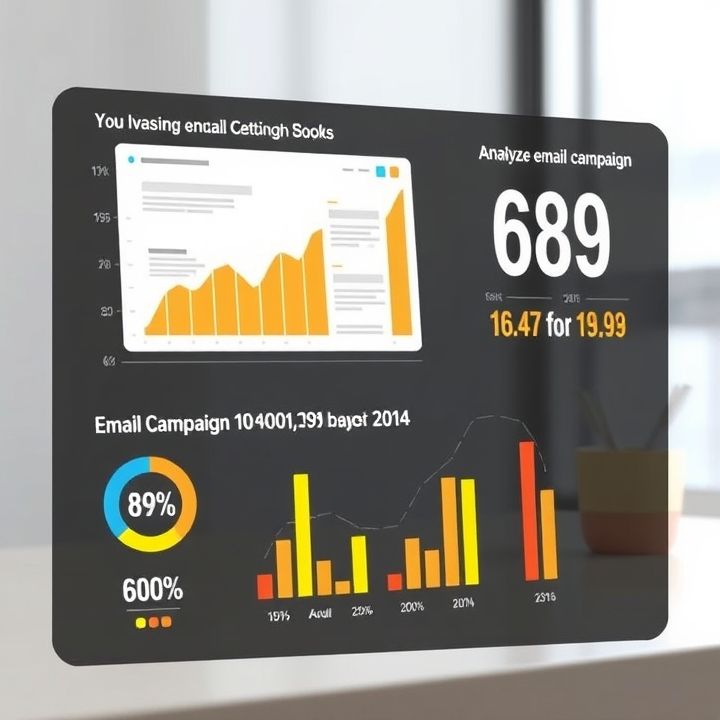Table of Contents
- Introduction
- Simplifying the unsubscribe process
- Offering email frequency preferences
- Personalizing content to user interests
- Providing alternatives to unsubscribing
- Ensuring clear and empathetic communication
- Utilizing analytics to understand unsubscribe reasons
- Testing different unsubscribe page designs
- Implementing feedback loops to improve content
- Conclusion
- Frequently Asked Questions
Introduction
In the fast-paced world of digital marketing, keeping your audience engaged is more challenging than ever. But what if the secret to drastically reducing your unsubscribe rates was within reach? Imagine transforming your email list monetization by engaging subscribers like never before.
Let’s take a closer look at the seven genius hacks that promise to revolutionize your email marketing strategy! To give you a visual insight, here’s a glimpse of how analyzing email campaign statistics can elevate your marketing efforts:
In this article, we will explore techniques ranging from personalized content to strategic email segmentation, and more—all designed to boost engagement and minimize those dreaded unsubscribe rates. Before we dive deeper, here’s a sneak peek at the secrets we’ll be unlocking:
| Hack | Benefit |
|---|---|
| Personalization | Increased Engagement |
| Segmentation | Targeted Content |
| Time Optimization | Maximized Open Rates |
Each hack is meticulously crafted to target your audience’s needs, ensuring your emails hold their attention and keep them on your list. Stay tuned as we delve into the intricacies of these transformative strategies.
Simplifying the unsubscribe process
Simplifying the unsubscribe process is crucial for maintaining a positive relationship with your audience and ensuring compliance with email marketing regulations. A seamless process demonstrates respect for your subscribers’ preferences and can lead to higher customer satisfaction. To achieve this, the unsubscribe option should be easily accessible, typically located at the bottom of marketing emails. It’s essential to use clear and straightforward language, such as ‘Unsubscribe,’ to guide users efficiently.
Implement a one-click unsubscribe mechanism to streamline the process further. This approach minimizes frustration and reduces the chances of subscribers marking your emails as spam. Offering a preference center can also be beneficial, allowing subscribers to adjust their email frequency or select specific topics of interest instead of a complete opt-out. This level of customization can retain subscribers by catering to their preferences.
Finally, confirm the unsubscribe action with a polite message and thank them for their past engagement. This closing touch not only confirms the process but leaves the door open for future interactions. By simplifying the unsubscribe process, you respect customer choices and pave the way for a more engaged and loyal audience.
Offering email frequency preferences
Offering email frequency preferences is a strategic approach to reduce unsubscribe rates and enhance subscriber satisfaction. By allowing subscribers to choose how often they receive emails, businesses can better tailor communication to individual preferences. This not only minimizes opt-outs but also fosters a sense of control and personalization among subscribers. Implementing frequency options can involve offering choices such as daily, weekly, or monthly emails. Providing a clear and easy-to-use mechanism for subscribers to update their preferences ensures they are not overwhelmed by too many emails. Moreover, it encourages them to remain engaged with the content. The process should be straightforward, placed prominently in emails, and possibly integrated into the preferences center on your website. Giving subscribers these options shows respect for their time and attention, ultimately building trust and loyalty. In addition, analyzing data on subscriber frequency preferences can offer valuable insights into segmenting audiences and optimizing email strategies effectively. By implementing these techniques, businesses can create a win-win situation where subscribers stay informed according to their terms, and companies maintain a healthier subscriber list.
Personalizing content to user interests
Personalizing content to user interests is a powerful technique in optimizing the unsubscribe process and minimizing opt-outs. By tailoring content to the preferences and behaviors of your audience, you ensure that each piece of communication resonates with them, increasing engagement and reducing the likelihood of unsubscribes. To achieve this, start by gathering data on user behavior, such as past interactions, purchase history, and demographic information. This data can then be leveraged to segment your audience into distinct groups with similar interests.
Once segmentation is complete, create customized content that speaks directly to the needs and desires of each group. For instance, if data reveals a subset of your audience frequently purchases fitness products, send them emails featuring workout tips, new product launches, or personalized discounts. Additionally, utilizing dynamic content blocks in emails allows you to adjust messaging for different users seamlessly.
Furthermore, offering users the option to update their preferences can empower them to choose the type and frequency of content they receive. This not only enhances their experience but also reduces the likelihood of them opting out. Overall, personalized content fosters a more meaningful connection with your audience, leading to higher satisfaction and retention rates.
Providing alternatives to unsubscribing
In the realm of email marketing, offering alternatives to unsubscribing is an effective technique to retain subscribers while respecting their preferences. One approach is to provide a simple option to change email frequency. For instance, allowing users to receive emails weekly instead of daily could reduce the perceived email burden. Another alternative is to offer a preference center where subscribers can customize the type of content they receive. By enabling users to select topics of interest, you ensure that they receive relevant content, reducing the likelihood of opting out entirely.
Additionally, consider offering a temporary unsubscribe or a pause option, which lets subscribers take a break without fully disconnecting, allowing them to return when they’re ready. Lastly, it’s crucial to communicate the value subscribers receive from staying on the list. Highlighting exclusive content, special offers, or insider updates can remind them of the benefits they might miss out on by unsubscribing. By implementing these strategies, businesses can not only reduce opt-out rates but also enhance the overall subscriber experience.
Ensuring clear and empathetic communication
Ensuring clear and empathetic communication is a vital technique in optimizing the unsubscribe process and minimizing opt-outs. It starts with designing a straightforward and user-friendly unsubscribe page. This means providing a visible and easily accessible unsubscribe link in every email communication, often located at the bottom. When users decide to unsubscribe, acknowledge their decision with kindness and understanding to leave a positive final impression.
Next, the language on the unsubscribe page should be clear and concise, with no jargon or complicated terms that might confuse the user. Empathy plays a crucial role here; expressing genuine regret for their decision to leave while reassuring them of the straightforward process can soften any negative feelings. Offering options such as adjusting email frequency instead of a complete opt-out can retain some subscribers.
Furthermore, personalized messages that reflect the brand’s tone can foster a sense of connection. By directly addressing the subscriber by name and demonstrating an understanding of their needs, businesses can reduce the likelihood of opt-outs. Monitoring feedback and analyzing reasons for unsubscribes is essential to continually refine the communication strategy, ensuring it remains effective and empathetic.
Utilizing analytics to understand unsubscribe reasons
Utilizing analytics to understand unsubscribe reasons is a crucial step in optimizing the unsubscribe process and ultimately minimizing opt-outs. By leveraging analytical tools, businesses can gain a clear insight into the patterns and behaviors of users who choose to unsubscribe. This involves collecting and analyzing data on when and why subscribers opt-out, which can be gathered through exit surveys, user feedback, or tracking engagement metrics such as open and click-through rates.
One effective technique is to categorize unsubscribe reasons, such as content irrelevance, frequency of emails, or if the recipient has simply lost interest. By knowing these details, companies can tailor their content strategy to better align with subscriber interest, maintaining engagement and reducing the likelihood of future unsubscribes. Analytics also help identify trends over time, revealing whether changes in content strategy have impacted unsubscribe rates. Furthermore, analyzing demographic information can uncover specific user segments that are more prone to opting out, allowing for targeted adjustments in strategy or personalization. Hence, by effectively using analytics, organizations can create more meaningful connections with their audience, leading to improved subscriber retention and customer satisfaction.
Testing different unsubscribe page designs
When aiming to optimize the unsubscribe process and minimize opt-outs, testing different unsubscribe page designs is crucial. The design and functionality of an unsubscribe page can greatly impact a subscriber’s final decision to leave or stay. A well-designed page can offer users a compelling reason to remain subscribed. To start, businesses can test various design layouts, from simple text-based pages to more interactive designs that include video content or animations.
One strategy might involve an exit survey or feedback form that helps understand the subscriber’s reasons for opting out. Additionally, providing options to adjust email frequency or content preferences may encourage subscribers to stay on the list rather than leaving completely. Testing these features in different formats can reveal what resonates most with the audience. Furthermore, A/B testing different color schemes, fonts, and button placements can lead to improved user engagement and reduced opt-out rates.
Effective unsubscribe page designs are often those that respect the user’s decision, provide a seamless experience, and offer alternatives to complete opt-out when appropriate. By continuously testing and refining these pages, companies can better retain their audience while respecting their communication preferences.
Implementing feedback loops to improve content
Implementing feedback loops is a crucial technique for improving content and minimizing opt-outs during the unsubscribe process. By gathering insights directly from users, businesses can tailor their content to better meet audience expectations and preferences. The first step in this process involves soliciting feedback from subscribers at key touchpoints, such as through emails or surveys, to understand their needs and preferences. It’s vital to make these feedback requests quick and straightforward to encourage higher response rates.
Once feedback is collected, analyze it to identify common themes and areas for improvement. This might involve modifying the frequency of communications, the type of content provided, or the way in which it is delivered. Furthermore, leveraging A/B testing can offer insights into what resonates best with different audience segments.
In addition, maintaining transparency about changes implemented based on feedback can further engage subscribers. By informing audiences how their input has affected content strategy, businesses can strengthen trust and foster a more engaging relationship, ultimately reducing the desire to unsubscribe. Continuous iteration and adaptation based on feedback loops ensure that content remains relevant and valuable to the audience.
Conclusion
In today’s competitive digital landscape, effectively managing unsubscribe rates is crucial for businesses striving to maintain a robust and engaged subscriber base. Implementing the ingenious hacks outlined in this article not only reduces unsubscribe rates but also enhances overall customer satisfaction. By simplifying the unsubscribe process, offering flexible email frequency preferences, and personalizing content, businesses can turn potential opt-outs into opportunities for building stronger connections with their audience. Furthermore, providing alternatives to unsubscribing, ensuring clear and empathetic communication, and harnessing the power of analytics and feedback loops contribute to refining email strategies and meeting subscribers’ expectations effectively.
Ultimately, these strategies foster a more meaningful interaction, promoting loyalty and long-term retention. As you apply these insights, remember that continuous adaptation and responsiveness to subscriber preferences are key to maintaining a satisfied and growing audience. Thus, by prioritizing customer-centric communication and ongoing optimization, you can transform your email marketing efforts into a powerful tool for achieving sustainable success.

